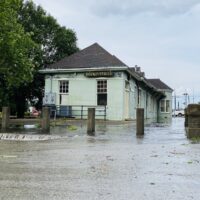Climate change can be a thorny topic at the dinner table, and in the classroom.
A pair of grants announced earlier this week are going to aid Kentucky Association for Environmental Education programs, including one aimed at increasing climate literacy among the state’s educators so that they can better teach their students.
A $100,000 grant from the Environmental Protection Agency is going to fuel research by KAEE and its partners in the Southeastern Environmental Education Alliance (SEEA) into barriers educators face when teaching about climate change.
The group hopes to do this by conducting a comprehensive landscape analysis of environmental education by surveying educators and administrators at schools across the southeastern U.S. KAEE’s goal is to equip schools and organizations doing environmental-related work with the tools to “address gaps, allocate resources more effectively, and ultimately meet the goal of increasing environmental literacy levels and stewardship behaviors.”
KAEE executive director Ashley Hoffman said a lack of understanding and confidence in the subject is one of the biggest roadblocks for teachers
“[Climate change] is one of the biggest environmental issues facing our world today and we have found through our research that educators don’t feel confident teaching about this – even though it’s part of the standards for various reasons,” Hoffman said. “Climate science is a very complicated topic. If they don’t feel comfortable and confident in the topic, how are they going to teach students about it?”
A recently released survey by the North American Association for Environmental Education indicated most teachers support efforts to teach climate change, but feel “unprepared” and “worry about pushback from parents.”
A second grant is providing a nearly $15,000 boost from the American Water Charitable Foundation is helping support a KAEE program designed to engage the state’s students in environmental initiatives.
The nonprofit’s revamped Green Schools program will allow young Kentuckians to aid in the design and implementation of cost-effective, environmentally friendly initiatives in schools.
Hoffman said the Green Schools program has been successful in the past, pushing schools to do things like install water bottle filling stations, launch recycling programs and other environmental projects.
“We’ve had student teams that have been able to save their schools thousands of dollars,” Hoffman said. “[That money] then goes back to supporting the school … and we’ve seen some really innovative things. The opportunity for students to be hands-on, active, engaged citizens at their school helps prepare them to be active, engaged citizens in the real world.”






